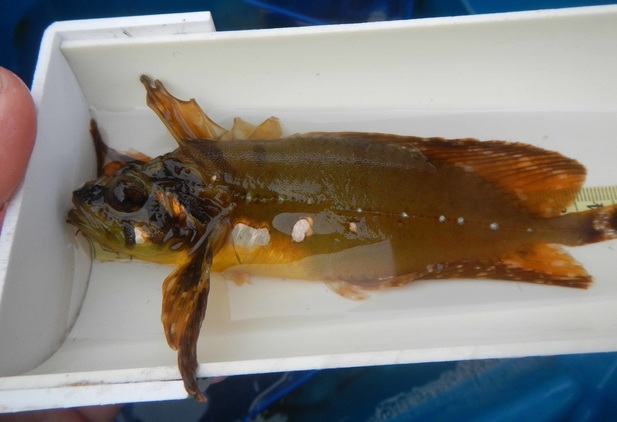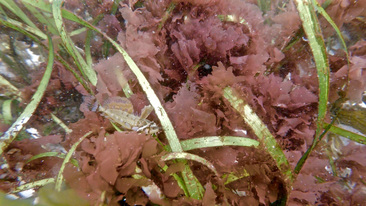Silverspotted sculpin • Blepsias cirrhosus
Left: silverspotted sculpin collected during a beach seine. Note the line of silver spots along the side, the golden brown colour, and the long, leafy-looking fins. Photo by Kaia Bryce. Right: photo by Tristan Blaine.
Identification
A tall and deeply notched first dorsal fin makes the silverspotted sculpin relatively easy to identify. It also has a line of silver spots running along each of its sides, and a patch of hair-like cirri projecting out from around its mouth. While it may be easy to identify, it can be quite difficult to spot: its prominent, leafy-looking fins and golden brown or dark green colouring help it camouflage among kelp. It gets to 20 cm long.
Habitat & Range
The silverspotted sculpin inhabits the intertidal and subtidal to depths of 40 m or more, though it is more common at relatively shallow depths. It blends in with kelp and eelgrass in rocky reefs and tidepools. Its range extends along coasts on both sides of the Pacific, from northern California to the Aleutian Islands and Bering Sea, and across to Asia as far south as the Sea of Japan.
A tall and deeply notched first dorsal fin makes the silverspotted sculpin relatively easy to identify. It also has a line of silver spots running along each of its sides, and a patch of hair-like cirri projecting out from around its mouth. While it may be easy to identify, it can be quite difficult to spot: its prominent, leafy-looking fins and golden brown or dark green colouring help it camouflage among kelp. It gets to 20 cm long.
Habitat & Range
The silverspotted sculpin inhabits the intertidal and subtidal to depths of 40 m or more, though it is more common at relatively shallow depths. It blends in with kelp and eelgrass in rocky reefs and tidepools. Its range extends along coasts on both sides of the Pacific, from northern California to the Aleutian Islands and Bering Sea, and across to Asia as far south as the Sea of Japan.
References
Froese, R. and Reyes, R. B. Hemilepidotus hemilepidotus (Tilesius, 1811). FishBase. Accessed 28/09/2015.
Lamb, A. and Edgell, P. Coastal Fishes of the Pacific Northwest. Revised. (2010). Madeira Park, BC: Harbour Publishing. Pp. 234-235.
Lamb, A., and Hanby, B. (2005). Marine Life of the Pacific Northwest [electronic version]. Madeira Park, BC: Harbour Publishing.
Authors and editors of page
Kelly Fretwell and Brian Starzomski (2015).
Froese, R. and Reyes, R. B. Hemilepidotus hemilepidotus (Tilesius, 1811). FishBase. Accessed 28/09/2015.
Lamb, A. and Edgell, P. Coastal Fishes of the Pacific Northwest. Revised. (2010). Madeira Park, BC: Harbour Publishing. Pp. 234-235.
Lamb, A., and Hanby, B. (2005). Marine Life of the Pacific Northwest [electronic version]. Madeira Park, BC: Harbour Publishing.
Authors and editors of page
Kelly Fretwell and Brian Starzomski (2015).





